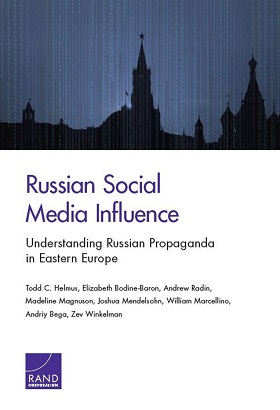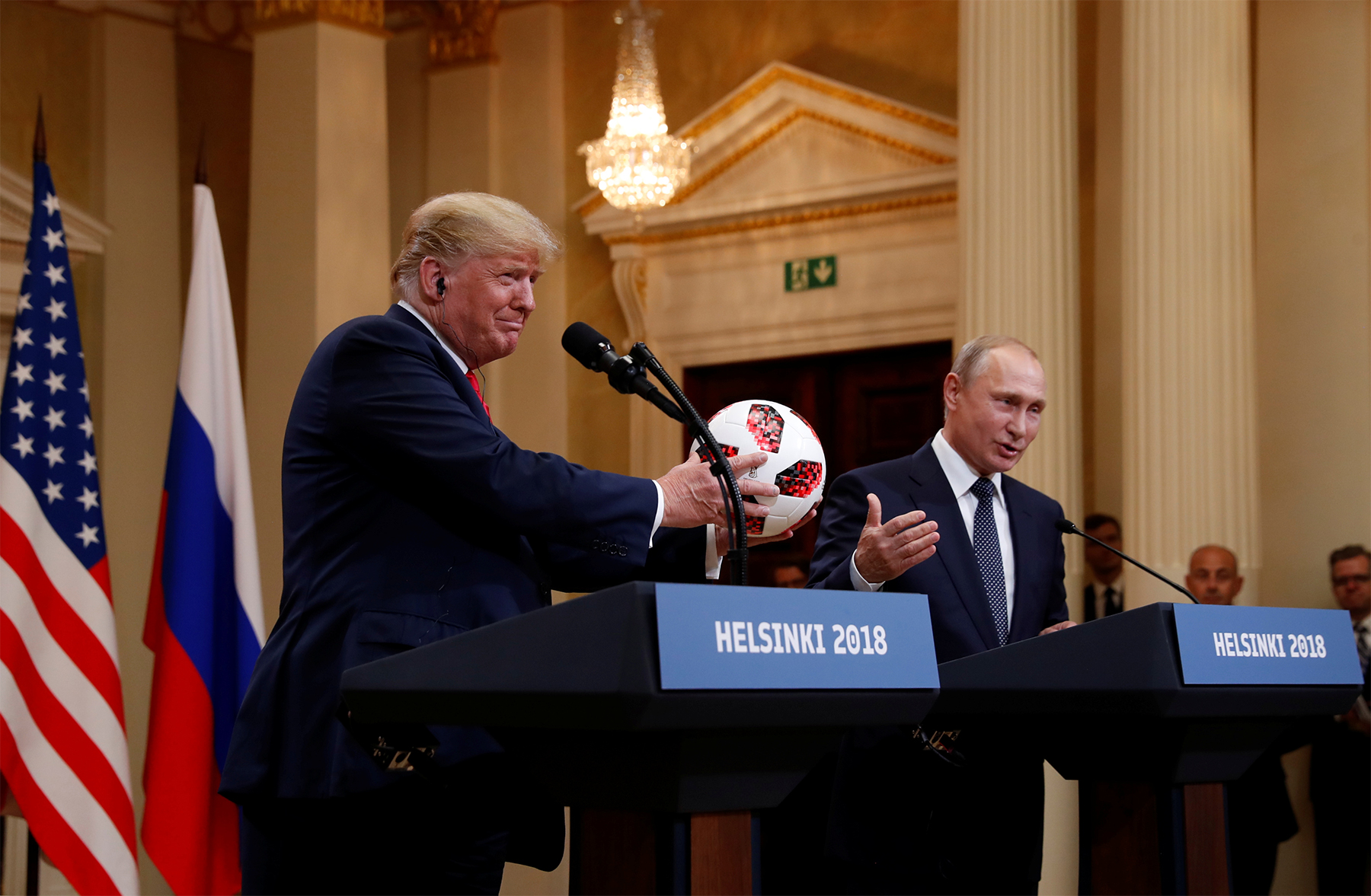“Russia is engaged in an active, worldwide propaganda campaign,” reads the fairly straightforward beginning of RAND Corporation’s report on Russia’s influence on East European countries via social media. The document, compiled by eight authors with support from the Office of the U.S. Secretary of Defense, looks into the nature and effectiveness of this influence and aims to identify possible countermeasures to it. The report is the latest in a series of publications by the research centre, which has close ties to the Pentagon, on how to counteract Russia. In particular, it complements the widely cited 2006 report “Reinforcing Deterrence on NATO's Eastern Flank,” which talked about the threat that Russia allegedly posed to the Baltic States and possible ways to deter it by conventional means. The new report extrapolates this logic to the digital space. Titled “Russian Social Media Influence,” it is a continuation of the collection of U.S. projects on Russia’s informational impact, which, in the light of the scandal concerning “Russian interference” in the 2016 presidential election, has turned into a new “major threat” for political circles in Washington.
The dispute involving key American think tanks, including RAND Corporation, extends to more general questions about the role of information in international relations. However, it poses a very practical question to Russia at the same time: what should Russia do about “Russian propaganda”?
“Russia is engaged in an active, worldwide propaganda campaign,” reads the fairly straightforward beginning of RAND Corporation’s report on Russia’s influence on East European countries via social media. The document, compiled by eight authors with support from the Office of the U.S. Secretary of Defense, looks into the nature and effectiveness of this influence and aims to identify possible countermeasures to it. The report is the latest in a series of publications by the research centre, which has close ties to the Pentagon, on how to counteract Russia. In particular, it complements the widely cited 2006 report “Reinforcing Deterrence on NATO's Eastern Flank,” which talked about the threat that Russia allegedly posed to the Baltic States and possible ways to deter it by conventional means. The new report extrapolates this logic to the digital space. Titled “Russian Social Media Influence,” it is a continuation of the collection of U.S. projects on Russia’s informational impact, which, in the light of the scandal concerning “Russian interference” in the 2016 presidential election, has turned into a new “major threat” for political circles in Washington.
The dispute involving key American think tanks, including RAND Corporation, extends to more general questions about the role of information in international relations. However, it poses a very practical question to Russia at the same time: what should Russia do about “Russian propaganda”?
What is Propaganda…
The main idea that runs throughout the second chapter of the new report is consonant with a quotation from a recent article in Vanity Fair on the “Russian threat” to the U.S. 2018 midterm elections and 2020 presidential election. “So what exactly is Russia planning for the upcoming election?” the author muses. “The correct question, a half dozen security experts and former and current government officials have told me, is what are they not planning?” To draw an analogy, the RAND report raises the question of what Russia does not influence.
The authors sound quite dramatic: “Moscow blends attributed, affiliated, and nonattributed elements and exploits new realities of online and social media to conduct information warfare at a perhaps unprecedented scale and level of complexity” (pp. 7–8). “The Russian government’s sphere of influence is global” (p. 9). “The Kremlin has built a complex production and dissemination apparatus that integrates actors at varying levels of attribution to enable large-scale and complex information operations” (p. 11).
These conclusions are based on a compilation of approaches and cases taken from English-language materials, most of them published after 2014. The authors do not question the results presented in the sources they cite; they give examples to illustrate their main thesis about the Russian information threat. The report achieves its primary goal of setting the context and leading the reader to the conclusion that “Russia is engaged in an aggressive propaganda campaign aimed at multiple different national audiences to include its near-abroad neighbors on its western border” (p. 25).
The main problem with this chapter and the report in general is that the authors do not even attempt to give a clear definition of what Russian propaganda is. On the contrary, the characteristics they mention – the complex, global and multilevel nature – render “Russian propaganda” potentially unlimited, and they can be arbitrarily attributed to any phenomenon whatsoever. The problem with such a comprehensive approach is that, if we bring it to its ultimate logical end, any information coming from Russia, or even any information about Russia with which the observer disagrees, may be viewed as propaganda. In this situation, the entire world is split into “us” and “them.” And this logic of confrontation is reflected in the report’s recommendations.
… How it can be detected…
The authors propose monitoring social networks as a method for counteracting “Russian propaganda.” In the third and fourth chapters of the report, they offer their own approach to analysing Twitter communities and the dissemination of pro-Russian information. The document uses Twitter data to identify pro-Ukrainian and pro-Russian communities and the most influential actors within them. The authors also determined the language signature of pro-Russian users and attempt to assess the impact of “Russian propaganda” on Twitter users in Ukraine, Belarus and Latvia.
This approach is interesting in terms of its methodology, but it has a number of significant flaws; the authors acknowledge some of these but disregard others. For example, one of the reasons they give for their choice of Twitter for analysis is that tweets are easily accessible. However, Twitter is not the most popular social network in the region: only 14 per cent of internet users in Ukraine, and 2 per cent of internet users in Estonia have a Twitter account (p. 27). The report suggests that opinion leaders on Twitter can also lead opinions on other offline and online channels, but this assumption does not appear to be convincing enough, as it is not supported by additional evidence.
A more serious flaw, one which the authors omit, is the geographical filter. One of the criteria used for the selection of tweets is the account’s location. The authors obtain the location data along with the rest of the data available through subscription to GNIP (this company, which aggregates data from social networks, was acquired by Twitter in 2014). According to GNIP, an account’s location is determined based on the information entered by the user themselves in the relevant box. If no such information is specified, GNIP does not attempt to determine the account’s coordinates in any other way. If several different cities, or even a made-up city, are entered, the GNIP algorithm will try to establish the location, but its guess will not necessarily be accurate. And those researchers who only use the data available from Twitter have no way of running a mass verification to establish the actual whereabouts of each user, even if the user in question provided accurate information about themselves.
No less controversial are the authors’ attempts to link pro-Russian Twitter activists with the Russian government. In the third chapter, they arrive at the conclusion that “many pro-Russia activists espousing a pro-Kremlin viewpoint hail from Russia and actively spread Russian propaganda on Twitter.” (p. 43) The authors acknowledge that the jury is out on whether or not the Russian government provides support to such users; nevertheless, “one can envision [italics added by me] Russia supporting these accounts either by creating nonattributed Twitter accounts that can serve as part of its bot and troll campaign or by supporting like-minded activists situated throughout the region adjacent to Russia” (p. 43). Yet further in the report the authors repeat several times that it is difficult to immediately distinguish authentic discussions from troll and bot activity.
The authors cite the opinions of regional experts to support their proposal to use this approach for monitoring the growth and geographic expansion of the pro-Russian Twitter community, since “such changes might presage pro-Russia influence and operations in the region that are more malign” (p. 59). However, given the aforementioned shortcomings of RAND’s approach, and its other flaws, it cannot be viewed as a reliable monitoring tool.
… And how to fight it
The report leaves the impression that it is very difficult for the West to tackle “Russian propaganda” in Eastern Europe: the United States, NATO and the European Union are not coordinated, and their awkward attempts at anti-Russian information operations in the region may well have the opposite effect – local Russian-speaking citizens are sceptical towards media which are openly sponsored by the West. The popularity of Russian media in the Baltic States presents the biggest threat, since it is difficult to compete with them for viewers. Worse still, due to their common past with Russia and the continuing infringement of their civil rights, Russian speakers in the region are more susceptible to information from Russia. This trend is additionally exacerbated by the discriminatory policy adopted by the regional authorities towards the Russian language. The differences between the region’s countries make the task of producing a single media product that would suit all audiences very difficult: on the one hand, “No one in Estonia wants to watch Latvian television” (p. 69); on the other hand, Ukraine’s approach, which involves the stringent censorship of information originating from Russia, is not that easy to replicate in the other countries in the region.
The authors suggest that these difficulties could be overcome by way of detecting, condemning and blocking propaganda on social networks. They propose using the experience gained as part of the Redirect Method programme developed by one of Google subsidiary companies aimed at countering Islamic State propaganda. The reports recommends that greater efforts be spent on promoting the United States, NATO and the European Union among Russian-speaking residents of Eastern Europe, as well as facilitating the creation of local content in Russian. In the latter instance, the authors recommend providing support to Russian-language influencers who have a “pan-European identity.” Contacts with NATO or the European Union are capable of undermining the reputation of such influencers, so the advice is for them to be supported by the local governments. However, this should be done with caution and, if possible, through local NGOs. Whether consciously or not, the authors’ proposal with regard to influencers brings them close to nonattributed Twitter activists, precisely those the report suggests the West should fight.
One of the recommendations in the report is potentially universal. Speaking about the need to increase immunity to propaganda among at-risk groups of the population, the authors effectively mean an increase in media literacy: developing people’s ability to process information and apply critical thinking. In a more benign political climate, raising media literacy could become a joint project of Russia and the West aimed at overcoming mutual misunderstanding and debunking mutual misconceptions. But the current situation is different; in keeping with the logic of informational confrontation, the RAND report does not contain proposals that could be implemented jointly with Russia.
Russian influence is the new black
In a broader context, “Russian Social Media Influence” reflects the interest of the U.S. research community in information influence, and in Russian information influence in particular. This interest has increased dramatically over the past few years. The authors of the report cite extensively from Clint Watts’s Messing with the Enemy: Surviving in a Social Media World of Hackers, Terrorists, Russians, and Fake News. Watts, a former FBI operative, described the recent changes to the Washington ecosystem in a recent podcast interview. According to him, prior to the 2016 presidential election, Washington’s main fad was cybersecurity, which had replaced counterterrorism, the fad of the 2000s. After the election, the U.S. capital focused on disinformation: “[W]e have these big booms in D.C. where everybody starts up a project around whatever the big threat is. And so, there is a lot of discussion, but the big difference today [from counterterrorism in the past] is the government isn’t leading it, it’s coming from like think tanks, and the academic community, and social media companies […].”
Watts’s words are corroborated by a review of the projects carried out by leading analytical centres in the United States over the past two years. Since 2016, nearly all of the centres engaged in foreign policy research on the University of Pennsylvania Top 15 ranking have either released reports on the influence of Russian information or mentioned the topic in their reports on Russia or U.S.–Russian relations (see the table). The only leading centres that have not launched projects on propaganda are the Cato Institute and Kennan Institute. In the latter case, however, it is only a matter of time: Nina Jankowicz, an expert on disinformation and a Global Fellow at the Kennan Institute, is working on a project entitled “How the West Can Learn from Eastern EU’s Experience Battling Russian Disinformation.”
Together, these projects indicate that the significant portion of the U.S. political elite agree that there is an informational threat emanating from Russia, and there is demand for such studies on the part of their sponsors. The reports offer a variety of proposals, which can be notionally graded from “modest,” including improvements to information exchange between the United States and its allies and the regulation of social networks, to really massive-scale proposals, such as covert measures by U.S. special operations forces “to combat Russian propaganda in Eastern Europe with truthful information about U.S. and allied activities and intentions” (Recalibrating U.S. Strategy Toward Russia, p. 156) or setting up a “Counter-Disinformation Coalition” (Democratic Defense Against Disinformation, pp. 13–14).
These numerous recommendations make no mention of the possibility to engage Russia itself in order to remove the West’s concerns about the information threat. The closest anyone comes is the following passage from the Council on Foreign Relations report: “The United States should make clear that it will continue to support free and fair elections, freedom of speech, and the rule of law in Russia, as it does all around the world. But it will respect Russia’s sovereign right to hold those elections free of outside manipulation with illicit means – just as it expects Russia to respect the United States’ right to do the same” (p. 22). This idea could be evolved into a dialogue on how both sides perceive information and political threats, if not into a mutual obligation to not intervene in each other’s internal affairs.
“Russian Propaganda” and Russia
“Russian propaganda” is being touted as one of the main problems for the West, but it understandably worries Russia itself. The comprehensive approach of the RAND report and other similar projects on information influence makes it possible to detect a Russian trace virtually everywhere, and to level accusations at Russia irrespective of whether or not the country is actually involved.
At the official level, Russia (just like the West) considers itself under an aggressive information attack. Just like the West is sceptical of Russia’s concerns about information threats, the Russian leadership does not believe, or is unwilling to believe, in the sincerity of the revived fears in the West about Russia’s information influence.
Ironically, the growing focus of the United States on information influence leads to a convergence of the U.S. and Russian approaches to international information security. For years, the fundamental difference between the two sides was that the United States viewed cybersecurity in the strict sense of network security, software security and information protection, whereas Russia was additionally concerned with how information being disseminated could influence public perception. However, the convergence of approaches is not enough to reach an agreement in this field: as demonstrated by the recommendations put forward by the leading U.S. analytical centres, the possibility of negotiating with Russia remains an unpopular option.
For an individual, information warfare may not appear particularly terrible or even entirely realistic: it can be “switched off” by merely pressing a button on your TV set or smartphone and returning to whatever you were doing. However, at the level of societies and states, in which information plays a key role, this strategy does not work and avoiding confrontation is not at all easy. In Russia’s relations with the West, both sides are attempting to question or discredit each other’s information, which exacerbates mutual distrust.
One possible way to revert this trend would be for both sides to agree to a “disarmament” of their rhetoric or information campaigns. This idea was voiced in 2017 by EU Ambassador to Russia Markus Ederer and Russian member of parliament Irina Yarovaya. Public diplomacy researcher Nicholas J. Cull recalls that Soviet and U.S. diplomats were discussing mutual stereotypes in the late 1980s. In practice, an “information disarmament” could include more substantive discussions on issues related to “incidents” in the information space and mutual accusations; coordinated measures such as a joint fight against common information threats; and also unilateral concessions such as opting for less belligerent rhetoric. The main objective of such information disarmament should be the restoration of mutual understanding between countries, but building trust between state and society is of no less importance. One way or another, this way could prove more effective than the promotion of “pan-European identity” by brand ambassadors on the backs of special operations forces.









